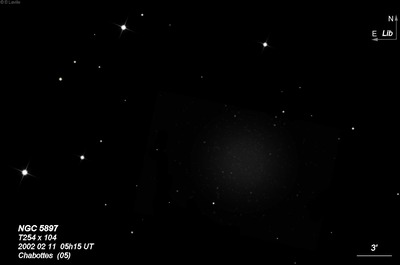
12x80 (6/30/84): very faint but visible in the finder!
William Herschel discovered NGC 5897 = H VI-19 = H VI-8 = h3596 on 25 Apr 1785 (sweep 209) and recorded VI-8 as "a very close compressed cluster of stars, 8 or 9' in diameter, extr rich, of an iR figure, a little E. The stars so small as hardly to be visible so accumulated in the middle as to look nebulous." There is nothing at his position and Dreyer chronicled the problems in the sweep in his 1912 "Scientific Papers of William Herschel".
Harold Corwin has an extensive discussion and argument that H VI-8 = NGC 5897. WH rediscovered this cluster a couple of weeks later on 10 Mar 1785 (sweep 383) and recorded VI-19 as "A beautiful L cluster of the most minute and most compressed stars imaginable. Different sizes and a faint red colour perceivable." His position on this sweep was only 3' south of center.
In 1914, Hardcastle classified NGC 5897 as a known spiral nebula (based on ?). The following year, Knox-Shaw reported it was a loose globular cluster and "certainly no a spiral nebula", based on a photograph taken between 1912-14 at the Helwan Observatory with the Reynolds reflector.
300/350mm - 13.1" (6/30/84): about two dozen faint stars resolved over irregular haze.
13.1" (6/19/82): a number of faint stars resolved over a larger region of haze.
400/500mm - 17.5" (6/3/00): large, loose, globular, ~10' in diameter with only a weak concentration and no core. At 280x, 60-70 stars are resolved in good moments of seeing and many appear to be arranged in strings (two on the east side of the halo) emanating from the central region. The extent of the halo is ill-defined.
17.5" (6/6/86): this is a low surface brightness globular of 10' diameter with little concentration. Roughly circular although the outline is irregular. Well resolved into 50 stars at 286x over haze although NGC 5897 is too large for a good view at high power. About 5' NNE of center is a string of three mag 11.5, 12 and 14 stars with a total length of 1.4'.
Notes by Steve Gottlieb